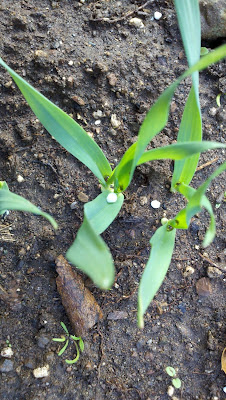
The
U Idaho Extension website that Henning posted gives a roadmap of what to expect for the coming weeks. The bere, pictured above, has four leaves and a coleoptillar tiller, which comes from below the ground.
Most of the Conlon now has a developing third leaf, which according to the U Idaho blog, is about a week behind the bere. The two varieties were planted at the same time, but develop at different rates.
In other news, I needed to finish fertilizing. I had applied 33 lb/acre right after emergence, but I should be closer to 60 lb/acre for the upper and middle fields (which grew soybeans last winter), and closer to 80 lb/acre for the lower field, which grew corn two summers ago and lay fallow last summer.
Because of the netting, I can't apply anything to the upper field. So, I laid down 1.25 lbs of urea on the middle and 2.5 lbs of urea on the lower. The total Nitrogen for upper, middle, lower is now 33 lb/acre, 56 lb/acre and 79 lb/acre.
It's worth thinking about this because you want to try to get the nitrogen in a sweet spot. Too little N and yield suffers through decreased tiller formation and fewer kernels per head. Too much N, and the protein in the finished grains will rise above 12.5%. This would still make beer, but 13% protein grain would be rejected by the malting industry. We've essentially never experienced high-protein barley, but I imagine it gives some problems similar to wheat and rye -- stuck sparges and hazy beers. The
Queensland website is still the best one for figuring out how much N to target.
I'm still not sure when it's best to apply N. Intuitively, you might want to apply it in several doses during the plants' vegetative growth, so that the plants get a steady supply. But
some extension websites claim that late N additions increase grain protein without affecting yield.
Another reason to fertilize early is this:

That urea chunk is right there in the middle of the plant, and if it's not removed or washed out, it will eventually burn the plant and kill it. Fortunately, there was only about one plant like this per row.
The field got an extra-good watering to help wash urea out of the plants and into the ground.












